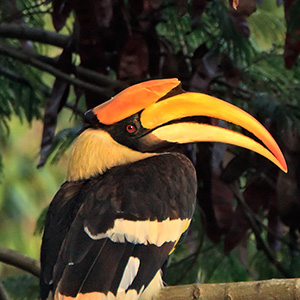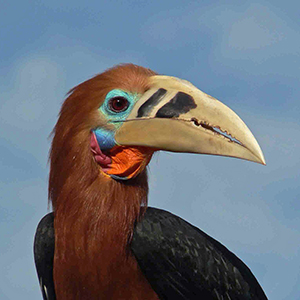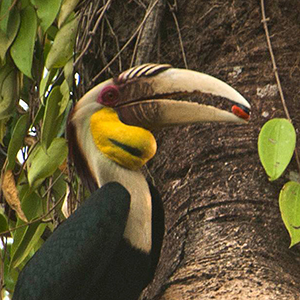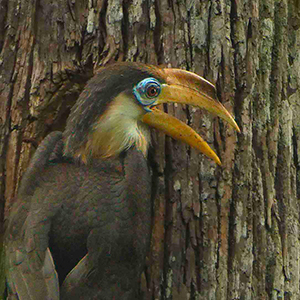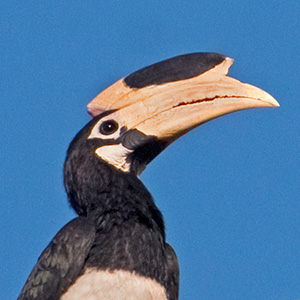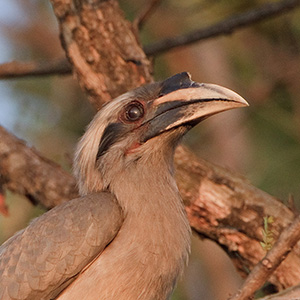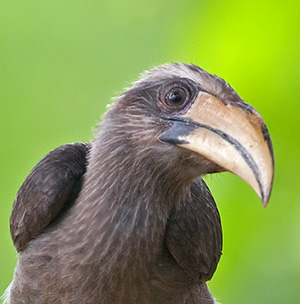
Oriental Pied Hornbill
Anthracoceros albirostris
Oriental Pied hornbill was previously named in error as Anthracoceros malabaricus. There are two distinct subspecies; the subspecies in India is A. albirostris. Males: length: 70 - 85 cm, body weight: 680 - 907 g; females: length: 60 - 65 centimeters, body weight: 500 - 879 gm. When flying, it can be differentiated from the similar-looking Malabar Pied Hornbill by its tail, which has more black. Male has creamy bill with large black base on mandible, large casque is cylindrical with black projecting front part, female bill and casque smaller, marked with black, lower mandible has dark red spot. They are very noisy and often call with squeals and chuckles; mostly their call is a cackling kek-kek-kek-kek. Both have pale blue skin around eyes and on throat.
Local Names: Cachari: Dao yung kashiba; Assamese: Kao dhanesh/Hay tuk tek ee; Wancho: Long-o; Miju Mishmi: Langsin; Nyishi: Garhe; Khampti: Kokey-khao; Mising: Tekteki.

Anthracoceros albirostris is found in south Nepal, south Bhutan, north Bangladesh, northern and north-eastern India, Myanmar, Mergui Archipelago, southern China, Vietnam, Laos, Cambodia, and parts of Thailand, Singapore, and north-east peninsular Malaysia. Its range possibly overlaps with Malabar Pied Hornbill (A. coronatus) in south Bihar, and hill forests of Orissa and West Bengal, but there are no known hybrids.
The species can be found in forest edge; open, moist deciduous and evergreen forests; riverine forest; secondary, logged forests; and even gardens and agricultural fields. Usually recorded up to 700 m elevation. It is common in riverine and secondary forests. Seen commonly in Rajaji National Park and Corbett Tiger Reserve in north India and in Nameri and Pakke Tiger Reserves and several other Protected Areas in north-east India, also common in forests outside Protected Areas.
This species is more commonly found in secondary forests, and unlike other Asian Hornbills, is not dependent on primary forests for feeding and breeding. The species has a mixed diet, but is largely frugivorous, eating fruits of secondary forest species, lianas, and of Lauraceae, Meliaceae and Annonaceae and figs (Moraceae). Around 30-40 species recorded in Pakke Tiger Reserve, and 49 species in Thailand. Some important food species are Polyalthia, Horsfieldia, Dysoxylum, and Talauma hodgsoni. Oriental pied Hornbills also eat many invertebrates such as insects, crabs, centipedes, millipedes, scorpions, spiders, snails, earthworms, lizards, birds, eggs and small vertebrates. Fifty-six species recorded in Thailand. They also catch fish and crabs in shallow pools and pick termites from termite hills.
The species is monogamous, sometimes territorial. The female seals the cavity, male recorded to provide earth/mud. Eggs are laid in Feb-Apr in Asian mainland, Sep-May in Malaysian and Indonesian islands, clutch is 1-4 eggs, incubation period is 25-The species is monogamous, sometimes territorial. The female seals the cavity, male recorded to provide earth/mud. Eggs are laid in Feb-Apr in Asian mainland, Sep-May in Malaysian and Indonesian islands, clutch is 1-4 eggs, incubation period is 25-33 days, female in nest for 66-100 days, female emerges with chicks or 20 days before chicks. Entire nesting cycle is 85-90 days (range 70-107 days) depending on geographical location. In north-east India, it is estimated to be between 93-97 days and breeding season is from early to mid-April to July. Chicks that hatch later may be weaker, either killed by female or starve and eaten by sibling or female. Various tree species used for nesting in SE Asia, while in north-east India, mostly recorded on Tetrameles nudiflora.
They like forest that is a little more open, and moves around in groups of 5-10 birds, calling to each other. Mainly seen in pairs or family groups, sedentary, territorial, flocks of up to 170 recorded in non-breeding season in Thailand. If they find a patch of loose mud on the ground, they do not miss the chance to enjoy a dust-bath
Listed as Least Concern (LC) on the IUCN Red List. Listed in Schedule 1 of the Wildlife Protection Act, India.
Widespread and locally common. Adaptable and opportunistic species, breeding in cultivated areas, near villages, can feed on ornamental fruit trees and also in the fringes of many Protected Areas. the fringes. In China, threatened by rapid conversion of habitat. Density is 21 birds per sq. km in Khao Yai NP, Thailand. Although the species can survive in degraded secondary forest, complete loss of forest cover, especially in lowland foothill forests may cause declines. It is hunted less than the other three larger species in north-east India. Hunted in some other areas in SE Asia for food and pet trade, but overall population not declining or threatened. Widespread and locally common. Adaptable and opportunistic species, breeding in cultivated areas, near villages, can feed on ornamental fruit trees and also in the fringes of many Protected Areas. the fringes. In China, threatened by rapid conversion of habitat. Density is 21 birds per sq. km in Khao Yai NP, Thailand. Although the species can survive in degraded secondary forest, complete loss of forest cover, especially in lowland foothill forests may cause declines. It is hunted less than the other three larger species in north-east India. Hunted in some other areas in SE Asia for food and pet trade, but overall population not declining or threatened.

